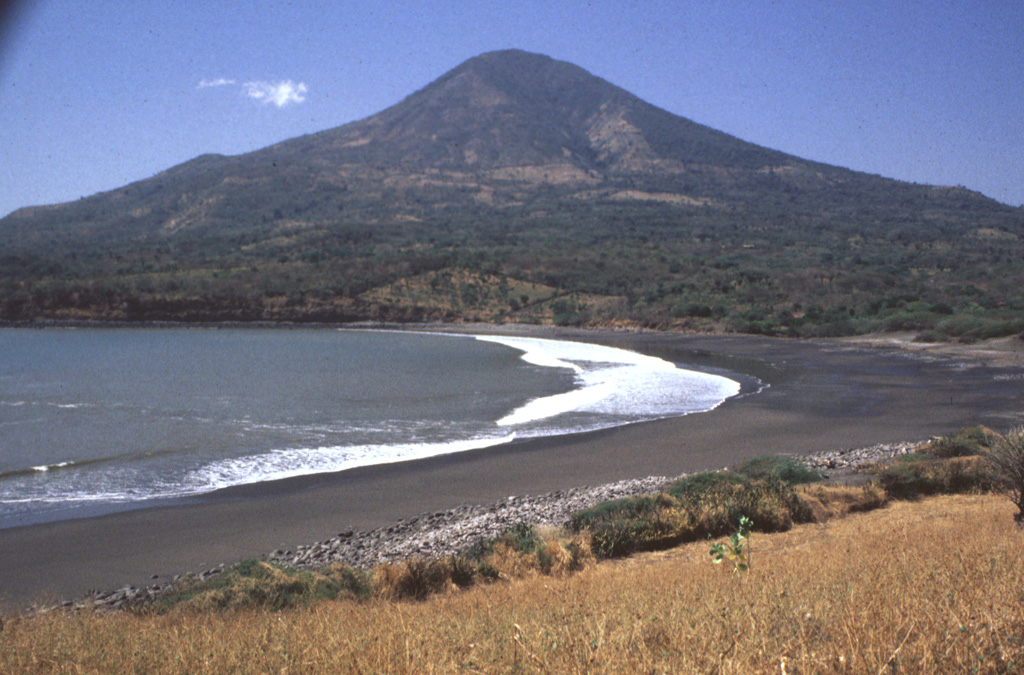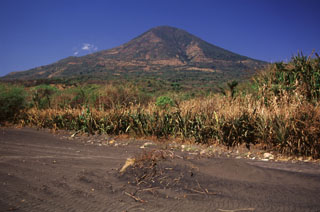

The Global Volcanism Program has no activity reports available for Conchagua.
The Global Volcanism Program has no Weekly Reports available for Conchagua.
The Global Volcanism Program has no Bulletin Reports available for Conchagua.
This compilation of synonyms and subsidiary features may not be comprehensive. Features are organized into four major categories: Cones, Craters, Domes, and Thermal Features. Synonyms of features appear indented below the primary name. In some cases additional feature type, elevation, or location details are provided.
Synonyms |
||||
| Cochague | ||||
Cones |
||||
| Feature Name | Feature Type | Elevation | Latitude | Longitude |
| Banderas | Stratovolcano | 1133 m | 13° 16' 48" N | 87° 49' 44" W |
| Ocotal | Stratovolcano | 1225 m | 13° 16' 30" N | 87° 50' 42" W |
|
|
||||||||||||||||||||||||||
The Global Volcanism Program is not aware of any Holocene eruptions from Conchagua. If this volcano has had large eruptions (VEI >= 4) prior to 12,000 years ago, information might be found on the Conchagua page in the LaMEVE (Large Magnitude Explosive Volcanic Eruptions) database, a part of the Volcano Global Risk Identification and Analysis Project (VOGRIPA).
There is no Deformation History data available for Conchagua.
There is no Emissions History data available for Conchagua.
 Conchagua is a conical, but deeply eroded basaltic to basaltic-andesite stratovolcano bordering the Gulf of Fonseca at the SE tip of El Salvador. Cerro de la Bandera, east of Cerro del Ocote, the summit of Conchagua, appears to be younger in age. Recently active fumarolic areas form barren spots on both peaks. Eruptions reported in 1522, 1688, 1868, and 1947 are erroneous, and may refer to landslides associated with earthquakes.
Conchagua is a conical, but deeply eroded basaltic to basaltic-andesite stratovolcano bordering the Gulf of Fonseca at the SE tip of El Salvador. Cerro de la Bandera, east of Cerro del Ocote, the summit of Conchagua, appears to be younger in age. Recently active fumarolic areas form barren spots on both peaks. Eruptions reported in 1522, 1688, 1868, and 1947 are erroneous, and may refer to landslides associated with earthquakes. Conchagüita (left), an island in the Gulf of Fonseca, and Conchagua (right) a volcano on the Salvadoran mainland are seen here across the Gulf of Fonseca from the NE on the island of Zacate Grande in Honduras. Both Conchagüita and Conchagua are extensively eroded, but a historical eruption was reported from Conchagüita. The NW flank of Isla El Tigre volcano forms the ridge extending into the sea at the extreme left.
Conchagüita (left), an island in the Gulf of Fonseca, and Conchagua (right) a volcano on the Salvadoran mainland are seen here across the Gulf of Fonseca from the NE on the island of Zacate Grande in Honduras. Both Conchagüita and Conchagua are extensively eroded, but a historical eruption was reported from Conchagüita. The NW flank of Isla El Tigre volcano forms the ridge extending into the sea at the extreme left. Conchagua volcano towers above sandy beaches along the Gulf of Fonseca at the SE tip of El Salvador. The 1225-m-high stratovolcano has a conical profile, but has been extensively eroded. The easternmost of two major summits, Cerro de la Bandera, is seen in this view from Punta el Chiquirín and appears to be younger in age. Recently active fumarolic areas form barren spots on both peaks of this little-studied volcano. Historical reports of eruptions appear to be erroneous, and may refer to landslides associated with earthquakes.
Conchagua volcano towers above sandy beaches along the Gulf of Fonseca at the SE tip of El Salvador. The 1225-m-high stratovolcano has a conical profile, but has been extensively eroded. The easternmost of two major summits, Cerro de la Bandera, is seen in this view from Punta el Chiquirín and appears to be younger in age. Recently active fumarolic areas form barren spots on both peaks of this little-studied volcano. Historical reports of eruptions appear to be erroneous, and may refer to landslides associated with earthquakes. Conchagua volcano has a conical profile when seen from the NE near Punta el Chiriquín. The volcano actually has a much more complex structure than seen here and has been extensively eroded. It has two principal summits. The eastern summit, Cerro de La Bandera, seen in this view, appears morphologically more youthful and is less dissected than Cerro del Ocote, which forms the 1225 m high point of the volcanic complex.
Conchagua volcano has a conical profile when seen from the NE near Punta el Chiriquín. The volcano actually has a much more complex structure than seen here and has been extensively eroded. It has two principal summits. The eastern summit, Cerro de La Bandera, seen in this view, appears morphologically more youthful and is less dissected than Cerro del Ocote, which forms the 1225 m high point of the volcanic complex.  The twin peaks of Volcán Conchagua appear in the distance on the left horizon in this view to the east from the summit of San Miguel volcano. Conchagua lies on the shore of the Gulf of Fonseca at the SE tip of El Salvador. The large lake in the center of the photo is Laguna de Olomega. Flat-topped Cosiqüina volcano in Nicaragua is visible in the far distance at the upper right across the Gulf of Fonseca.
The twin peaks of Volcán Conchagua appear in the distance on the left horizon in this view to the east from the summit of San Miguel volcano. Conchagua lies on the shore of the Gulf of Fonseca at the SE tip of El Salvador. The large lake in the center of the photo is Laguna de Olomega. Flat-topped Cosiqüina volcano in Nicaragua is visible in the far distance at the upper right across the Gulf of Fonseca.Maps are not currently available due to technical issues.
There are no samples for Conchagua in the Smithsonian's NMNH Department of Mineral Sciences Rock and Ore collection.
| Copernicus Browser | The Copernicus Browser replaced the Sentinel Hub Playground browser in 2023, to provide access to Earth observation archives from the Copernicus Data Space Ecosystem, the main distribution platform for data from the EU Copernicus missions. |
|
WOVOdat
Single Volcano View Temporal Evolution of Unrest Side by Side Volcanoes |
WOVOdat is a database of volcanic unrest; instrumentally and visually recorded changes in seismicity, ground deformation, gas emission, and other parameters from their normal baselines. It is sponsored by the World Organization of Volcano Observatories (WOVO) and presently hosted at the Earth Observatory of Singapore.
GVMID Data on Volcano Monitoring Infrastructure The Global Volcano Monitoring Infrastructure Database GVMID, is aimed at documenting and improving capabilities of volcano monitoring from the ground and space. GVMID should provide a snapshot and baseline view of the techniques and instrumentation that are in place at various volcanoes, which can be use by volcano observatories as reference to setup new monitoring system or improving networks at a specific volcano. These data will allow identification of what monitoring gaps exist, which can be then targeted by remote sensing infrastructure and future instrument deployments. |
| IRIS seismic stations/networks | Incorporated Research Institutions for Seismology (IRIS) Data Services map showing the location of seismic stations from all available networks (permanent or temporary) within a radius of 0.18° (about 20 km at mid-latitudes) from the given location of Conchagua. Users can customize a variety of filters and options in the left panel. Note that if there are no stations are known the map will default to show the entire world with a "No data matched request" error notice. |
| UNAVCO GPS/GNSS stations | Geodetic Data Services map from UNAVCO showing the location of GPS/GNSS stations from all available networks (permanent or temporary) within a radius of 20 km from the given location of Conchagua. Users can customize the data search based on station or network names, location, and time window. Requires Adobe Flash Player. |
| Large Eruptions of Conchagua | Information about large Quaternary eruptions (VEI >= 4) is cataloged in the Large Magnitude Explosive Volcanic Eruptions (LaMEVE) database of the Volcano Global Risk Identification and Analysis Project (VOGRIPA). |
| EarthChem | EarthChem develops and maintains databases, software, and services that support the preservation, discovery, access and analysis of geochemical data, and facilitate their integration with the broad array of other available earth science parameters. EarthChem is operated by a joint team of disciplinary scientists, data scientists, data managers and information technology developers who are part of the NSF-funded data facility Integrated Earth Data Applications (IEDA). IEDA is a collaborative effort of EarthChem and the Marine Geoscience Data System (MGDS). |